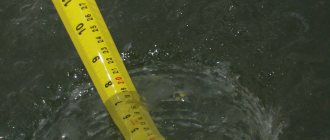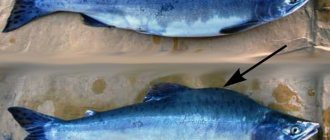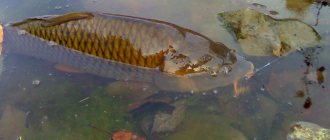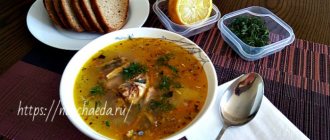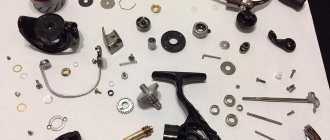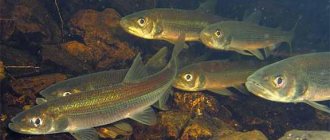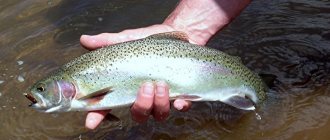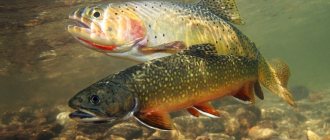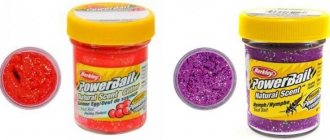Trout usually refers to several species of fish belonging to the salmon family. All of them are the desired prey of every fisherman, but they can only be found in reservoirs with very clean water, in addition, this breed is characterized by innate caution and timidity, so in order to get a catch you will need to master the appropriate skills. All features related to the choice of gear and fishing tactics will be discussed in detail in this article.
Gear selection
Which spinning rod is better to use?
For trout fishing, a feeder or float rod is often used, but every sufficiently experienced fisherman knows that spinning is the most effective in this process.
The following types of gear are best suited:
- Stream gear has a higher level of sensitivity of the blanks, which allows you not to miss even minor bites
Standard slow action spinning rods are best suited for trout fishing in ponds. Their use allows you to minimize the risk of prey disappearing even with active resistance from the caught fish; moreover, the small diameter of the rod and the light weight of the spinning rod make the fishing process much more interesting. All models belonging to this class are designed to work with small baits, so miniature oscillating spoons are a good choice. This allows beginners to master all the specifics of trout fishing, as well as expand the list of possible prey, since there is a possibility of bites from dace or roach.
- Stream spinning rods are highly specialized gear, since they were originally developed for catching various fish of the salmon family, including trout. They differ from the previous variety in their fast action, impressive power reserves and large dough. This allows them to be used to catch the largest individuals living in rivers with rapid currents. The fast action allows you to practice twitch fishing, which greatly expands your arsenal of artificial lures. Stream gear has a higher level of sensitivity of the blanks, which makes it possible not to miss even minor bites: usually the angler receives information about them not only by observing the tip of the rod, but also with the help of vibrations that are transmitted from the spinning rod to the hands. Another advantage of this option is improved flight characteristics, which has a positive effect not only on the range, but also on the accuracy of the casts. Despite the narrow specialization of stream models, many anglers noted that they are no less effective when catching other types of predators.
Equipment
After choosing a suitable fishing rod, you can proceed to preparing the equipment, which should look like this:
- The working line should be made of fluorocarbon, the diameter should not exceed 0.2 cm. Most experts advise against using braided cords: they have a high level of sensitivity, but do not actually stretch, which negatively affects the quantity and quality of bites.
- A leash is not a mandatory part of the equipment, but often the final catch depends on its presence, since trout is a very cautious fish. The recommended length is about 75 cm, the diameter should be smaller than that of the main line.
- A swivel must be installed , which is necessary to prevent the main line from twisting when the bait makes rotating movements.
- An inertia-free reel, which has two main requirements: the presence of a reverse stopper, characterized by instantaneous operation and a high degree of reliability, as well as a high gear ratio. If these requirements are met, the fishing process will be significantly simplified, since there will be no need to quickly rotate the handle when retrieving. You can check the reliability of the device by the speed and quality of laying the line, as well as the fixation of the line-laying arm.
A leash is not a mandatory part of the equipment, but often the final catch depends on its presence
Which spinning rod to choose for trout fishing - an overview of the main characteristics
Content
Beginning fishing enthusiasts are faced with the problem of choosing a spinning rod model for trout hunting. After all, fishing stores offer various types of fishing rods, and without the advice of professionals, it is problematic to choose a spinning rod. And although sales consultants will be happy to tell you which spinning rod is suitable for fishing, it is important to figure out this issue yourself. Each fishing enthusiast is guided by his own evaluation criteria.
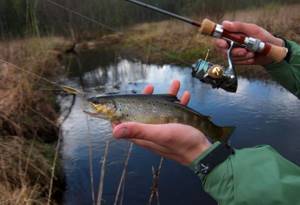
Fishing success depends on choosing the right spinning rod
Beginning spinners believe that a spinning rod should have the following characteristics:
- reliability;
- ease;
- versatility.
It's hard to argue with this. However, professional fishermen focus primarily on the structure of the spinning rod. This characteristic reflects the ability of a spinning rod to respond to fluctuations in load.
The system determines:
- possible wiring options and smoothness;
- accuracy of the cast;
- the distance to which the leash with bait is thrown;
- spinning whip sensitivity;
- the ability of the rod to smooth out jerks when fishing.
When choosing spinning rods for catching pond trout or river fish, pay attention to the bending of the spinning rod under load.
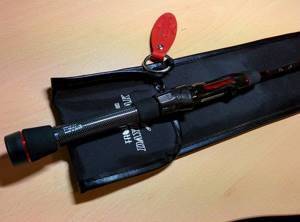
First of all, professional fishermen focus on the spinning system.
According to this criterion, spinning rods are classified as follows:
- Extra Fast (accelerated) – when loaded, 1/4 of the length of the whip, located in the upper part of the rod, bends radially. This design nuance guarantees increased casting accuracy and minimal smoothness when playing with the bait;
- Fast (fast) – when casting and retrieving fish, 1/3 of the length of the tackle is deformed. As a result, the retrieve is smoother, the shock-absorbing characteristics when retrieving fish are increased, but the hooking speed is reduced;
- Medium – in the process of retrieving and retrieving the catch, the upper half of the spinning rod bends. Such a rod intensively smoothes out the jerks of strong fish when playing, but is inferior in sensitivity and accuracy;
- Slow – the rod bends evenly along the length of the whip, acquiring a parabolic configuration. Thanks to its uniform bending, the whip quickly returns to its original state, providing increased casting distance and increased smoothness when retrieved.
Read more
How to choose the right spinning rod for trolling?
Along with the rigidity of the rod, you need to pay attention to the following points:
- permissible weight of the bait being thrown;
- number of sections and length of the spinning whip;
- material used to make the handle;
- spinning sensors;
- reliability of fastening of the reel seat and guide rings.
After analyzing the rating of spinning rods for trout fishing, choose light or ultra-light class rods that have a fast action. These types of rods work well with light bait, which is used when landing trout. Also pay attention to the material from which the whip is made. The best spinning rods for trout fishing are made on the basis of carbon fiber, which provides the required plasticity and improved response during the retrieving process, as well as when pulling in resisting prey.
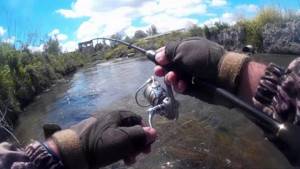
The best spinning rods for trout fishing are made from carbon fiber.
When choosing a spinning rod, consider the location of your upcoming fishing:
- It is advisable to use a short spinning rod on an overgrown bank;
- To lure them out of holes in open reservoirs, you will need an extended spinning rod.
Spinning rods of domestic and foreign production are used for trout fishing. The models have the following characteristics:
- whip length in the range from 170 to 300 cm;
- rod test ranging from 1 to 10 grams;
- tuning Fast (fast) or Medium (medium).
A properly selected spinning rod can cast a light bait far and accurately and, after biting, confidently reel in a strong and wary fish.
Lures for fishing
Natural baits
Trout is an omnivorous fish, and its preferences depend largely on the food to which it is accustomed to the presence in the reservoir.
The most successful natural type baits can be:
- Earthworms , especially those with a bright red color.
- Various types of larvae , including maggots and bloodworms.
- Various types of insects, including flies, bees, grasshoppers, beetles, midges, caterpillars, fireflies. Such baits are most effective in the summer, since at this time insects form the basis of the trout's diet.
- Crab sticks.
- Shrimp, squid , crab meat.
- Fresh fish , cut into small pieces.
- Small fish with an elongated body; such live bait can be bleak, dace, gudgeon or minnow. Such baits are usually used in the autumn, since trout begin to eat off before the onset of winter cold and are quite active.
- Pressed pieces of bread.
- Barley, corn.
- Cheese , especially various aromatic varieties.
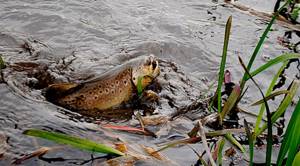
Artificial baits
Various artificial varieties of bait are used much more often, since spinning rods are most often used for trout fishing.
Here the fisherman is given a certain freedom of choice, since he can use the following assortment:
- Spoons. Rotating models are the most effective; the optimal size is No. 3. They have an interesting and active game, and they can be used at different depths. The color depends on the characteristics of a particular reservoir, but it is noted that the most often catchable lures are spotted, silver or golden baits.
- Wobblers are no less popular when fishing for trout; it is recommended to use oscillating models with a body length of 4 to 10 cm, depending on the size of the intended prey. They are able to copy as faithfully as possible the appearance and style of behavior of the fry, which does not arouse any suspicion in the trout and provokes it to attack. If the prey is passive and there is no bite for a long time, you can use castmasters, since they can arouse interest even in well-fed fish.
- Flies are distinguished by their versatility, as they can be used to bury and lure trout from the bottom or to sit passively on the surface of the water. Such baits are used only in cases where the plan is to fish for small prey.
- Streamers show a high degree of efficiency, which is due to their versatility. The variety of shapes, sizes and colors allows you to catch trout in virtually any conditions.
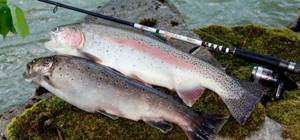
Lures
Trout is a predator that can be caught with almost any bait. Much depends on the time of fishing, weather, water temperature and the mood of the underwater inhabitant. The most effective for this fish are:
- wobblers;
- microoscillators;
- silicone baits;
- turntables.
Each lure has its own advantages and disadvantages, but with the right approach, any one can entice a trout to bite.
Fishing technique
To get a large trout catch, it is not enough just to choose the right spinning rod and equipment; you must also take into account the features of fishing techniques, which are discussed below:
- When approaching the fishing spot, you must take precautions, since trout can be scared off not only by loud sounds, but also by sudden movements. Particular care must be taken if progress is made in the direction of the current.
- Casting bait should be carried out from a reliable shelter , since during clear and good weather trout are able to notice the angler and his movements from a distance of 25 meters.
- It is highly effective to cast bait in the direction of the current , and then carry out the slowest possible retrieve against it.
- If there are underwater obstacles along the path of the bait, it is necessary to pause: the retrieve is interrupted for about 5-10 seconds and usually the fish attacks at this very moment.
- Many fishermen try to avoid places with complex bottom topography and a large number of underwater obstacles, which is a common mistake. The best option would be to fish such areas using surface-type floating wobblers; this will allow you to better study the reservoir and understand the peculiarities of the location of the catch, while there is virtually no risk of losing the equipment.
- When fishing during the daytime, you need to look for prey at great depths ; it prefers to stay close to sunken snags and other underwater shelters.
- Trout does not always immediately respond to bait, so at each selected area you need to make at least 5-10 casts. Even if in such cases there are no bites at all, a rational solution would be to move to nearby places.
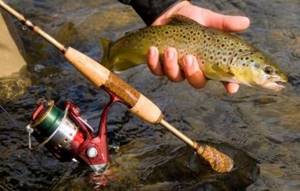
General fishing recommendations
The trout bite greatly depends on the choice of bait. In order to find the treasured key to the fish, you have to constantly experiment. The bait should be presented quietly and unnoticed. It is advisable to use a fan version of fishing a promising location.
Important. First, the coastline is combed with a gradual increase in casting distance. If there is no bite in the tested place, you can immediately move to another position.
It is necessary to pay attention to trees hanging over the water, areas of the reservoir with a rocky bottom. Here the predator can hide before attacking.
In areas with a rocky bottom, it is better to use floating wobblers. This measure will reduce the number of dead holds. You should use the reel clutch, skillfully using a spinning rod. When biting, the reaction should be immediate. You need to fish confidently and quickly.
Armed with knowledge and prepared gear, you can go in search of a trophy. Remember that fish belonging to the salmon family are distinguished by their fighting character and endurance. Another quality is their caution. Therefore, on your first fishing trip you may be left without a catch. But you will gain experience and relax in nature. Have fun fishing!
Fishing Features
On paysites
Today there are a large number of reservoirs in which trout are bred artificially.
Many fishermen prefer paid fishing because it has the following positive aspects and features:
- In such reservoirs, there is guaranteed to be prey , since employees of fishing bases always maintain the population size and are ready to give all recommendations for obtaining a rich catch.
- In fact, in all paid reservoirs, rainbow trout is artificially bred - this is a breed brought from America and prefers to live in cool waters. Taking this feature into account, it is necessary to search for it at great depths, using suitable bait.
- Before going to a paid reservoir, it is best to find out the conditions of the banks, as well as the possibility of fishing from boats. This will allow you to select a suitable spinning rod in advance, since the length of the rod will depend on the fishing conditions.
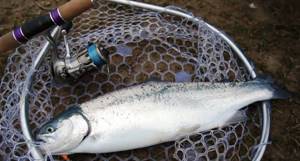
In fact, rainbow trout is artificially bred in all paid reservoirs - this is a breed brought from America and prefers to live in cool waters
Fishing seasons
The behavior of trout can change in different seasons; without taking this feature into account, it is impossible to get an impressive catch.
The specifics of fishing depending on the specific season are discussed below:
- Trout fishing is popular all year round, but in winter only the most experienced anglers decide to try it. This is due not only to worsening weather and temperature conditions, but also to the passive behavior of prey. Winter fishing is carried out from ice; mainly a special type of spinner is used as bait, but jigs, balancers or trout paste can also show a high degree of efficiency. This breed goes to the same parts of the reservoir for the winter every year, so it’s enough to simply detect them and return to these places every winter, selecting the most catchy bait.
- At the beginning of spring, the specifics of trout fishing differ little from winter fishing, since the prey continues to remain in the pits and shelters in which the winter took place. Gradually, the water warms up, and the fish begins to more actively explore the reservoir in search of food, its appetite begins to awaken, which leads to an increase in the number of bites. The melting of ice and snow leads to a rise in the water level and its cloudiness; fishing during this period is the most difficult, since in such conditions it is extremely difficult to find trout risers.
- In summer, fishing in hard-to-reach places, for example, near underwater snags, is considered the most promising. To study them, it is best to use small wobblers, which must be equipped with powerful and well-sharpened tees, since due to difficult fishing conditions it is necessary to immediately hook the detected fish. Another common bait that is used in the summer are spinners. The main requirement for any bait is an active and interesting game, since at this time the reservoirs are teeming with food, and you need to try to attract the attention of trout.
- The autumn period is considered the most successful for trout fishing, since it ceases to be so shy and is characterized by quite active behavior, which leads to a good and stable bite. This is due to the approach of winter, so the fish begins to eat more, increasing fat deposits. In autumn, it is recommended to use natural baits, for example, maggots or bloodworms, although various spinners and wobblers can also bring a rich catch.
Wobblers
These lures are good when trout are feeding in the upper layers of the water. Their active and realistic play can attract the attention of a moving predator and force it to attack a passing object.
Trout can be caught using wobblers of different classes and buoyancy. It is necessary to select a specific model, taking into account the mood of the predator and the horizon in which it feeds.
In spring and autumn, when trout are relatively active, it is better to fish with cranks. Their aggressive play can attract its attention from a long distance, and their realistic movements will not arouse suspicion in the fish. If the predator is in apathy, then it is advisable to try a minnow.
Advice! When trout are feeding near the bottom, you need to use sinking crankbaits.
The top best models of wobblers for trout fishing are as follows:
- "Smith Camion";
- "Zipbaits Rigge 35F";
- "Zipbaits Hickory";
- "Megabass Baby Griffon";
- Smith Jade MD;
- "Lucky Craft Cra-Pea";
- "Ima Imatetra."
In general, there are a lot of catchy models of trout wobblers and every angler has his own favorites.
Spinners
Pinwheels are the most versatile trout lures. They can catch a predator in any body of water at any time of the year. Mastering trout fishing with these lures is the easiest.
The size of trout spinners should be small. Increased demands are placed on the quality of their execution. A good spinner works flawlessly at any fishing speed and does not scare away the fish.
Microoscillators
This type of bait is increasingly gaining popularity and is gradually pushing aside both wobblers and spinners. Micro-oscillators are perhaps the best for trout fishing on paid reservoirs. They realistically imitate small fish, so the predator cannot resist and will certainly make a grab.
Micro-oscillators are effective at any time of the year. It produces its best catches in spring and autumn, although in summer trout do not hesitate to take these baits. With their help, an angler can fish any horizon, plunging the spoon both to the bottom and holding it near the surface.
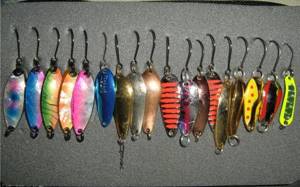
Photo 3. Trout “shakers” are elegant, like the trout itself.
The most popular models of microoscillators are:
- Smith Pure;
- "Forest MIU";
- "Forest Crystal";
- "Coatac"
- "Daiwa COHO";
- "Forest Marvel";
- "Smith Heaven"
Blitz tips
The article examined all the main features associated with trout fishing and the choice of a suitable spinning rod; to summarize, we can give the latest recommendations:
- Trout has a high degree of gluttony , so you don’t have to worry about overfeeding it, as happens with other breeds.
- If it is impossible to get sexually mature insects , you can use their larvae; for trout there is not much difference, and it calmly reacts to such a replacement.
- Particular care must be taken if flies are used as bait. In this case, you need to use the thinnest line possible so that the fish cannot see it.
Choosing a fishing line and leash for trout fishing with a spinning rod
A fishing line for trout fishing on a spinning rod is a serious element of equipment that transfers the force from the bite to the end of the rod.
The following types of fishing line are used:
- monoprofile. It is made of nylon thread, unnoticeable in water, which has increased stretchability and works effectively with various types of baits;
- wicker Used less frequently than profile. Used for long-distance and accurate casting over a distance of over 20 meters. The braid has good sensitivity.
Most spinning anglers consider the following fishing line characteristics to be the most important:
- ability to stretch under load;
- inconspicuous in water for cautious fish;
- elastic properties without causing a springing effect.
The specified criteria correspond to monofilament with a diameter of 0.18-0.25 mm with a breaking load of more than 3 kg. The predator is quite picky about the color of the fishing line. It is advisable to use a colorless thread or fishing line with a greenish or yellowish tint.
Read more
How to catch carp with a spinning rod?
The requirements for the fishing line also apply to the leash, which should be secured through a swivel to prevent the thread from twisting during the rotational movement of the bait.
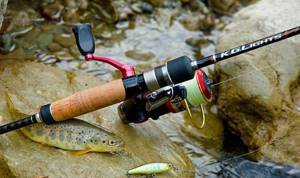
A serious element of fishing line equipment for trout fishing on a spinning rod
Main characteristics of the leash:
- length – no more than 0.75 m;
- diameter – up to 0.2 mm.
When choosing fishing line for the main thread and leader, the manufacturer is not important. Monofilaments of domestic production and foreign production are comparable in characteristics.
Advantages of spoons when fishing for trout
I don’t want to say that oscillating spoons catch fish better than wobblers or spinners. Just don’t forget about this class of baits and try to use them along with others. And in some cases you simply cannot do without oscillations.
On one of the trips I fished in a reservoir with trees standing separately along the shore. Some of them were tilted over the water. A branch was floating in the water about fifteen meters from the shore. During one of the casts, the line got caught on it, and I carefully lifted the bait up to throw it over the branch at the last moment. I paused before swinging and immediately got a bite. While fishing for the fish, the line slipped and the trout was pulled out. Immediately I changed the spoon to a lighter one with a single hook and consciously threw over the branch. He began to pull the bait to the surface and throw it into free fall. I caught another trout in this way until the branch was near the shore. Since then I have used this technique whenever possible, and it sometimes helps out.
Another find, and as usual, by accident. During the next cast, a beard happened. While I was unraveling the fishing line, the spoon sank to the bottom. It was equipped with a single hook, so when the beard came undone, I began to slowly drag it along the bottom. I liked the idea, I didn’t regret the possible snag and breakage. I dragged the bait along the bottom for about a meter, then made a sharp jerk upward with the tip of the spinning rod, let the bait fall, left it motionless for a few seconds and then repeated the cycle. Literally a few retrieves after the spoon was raised again above the bottom, there was a bite and a trout was caught. I use this method extremely rarely, and only two fish were caught this way, but there is something in it and the research can be continued.
It is much more convenient to fish along the shore in shallow water with oscillating spoons than with other types of bait. Because you can easily select the desired weight of the bait at the smallest size.
